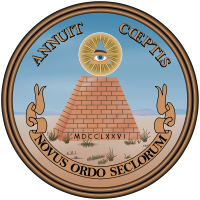
Annuit Cœptis
Encyclopedia

Motto
A motto is a phrase meant to formally summarize the general motivation or intention of a social group or organization. A motto may be in any language, but Latin is the most used. The local language is usual in the mottoes of governments...
s on the reverse side of the Great Seal of the United States
Great Seal of the United States
The Great Seal of the United States is used to authenticate certain documents issued by the United States federal government. The phrase is used both for the physical seal itself , and more generally for the design impressed upon it...
. (The second motto is Novus ordo seclorum
Novus Ordo Seclorum
The phrase Novus ordo seclorum appears on the reverse of the Great Seal of the United States, first designed in 1782 and printed on the back of the United States one-dollar bill since 1935. The phrase also appears on the coat of arms of the Yale School of Management, Yale University's business...
; Another motto appears on the obverse side of the Great Seal: E pluribus unum
E pluribus unum
E pluribus unum , Latin for "Out of many, one", is a phrase on the Seal of the United States, along with Annuit cœptis and Novus ordo seclorum, and adopted by an Act of Congress in 1782...
). Taken from the Latin
Latin
Latin is an Italic language originally spoken in Latium and Ancient Rome. It, along with most European languages, is a descendant of the ancient Proto-Indo-European language. Although it is considered a dead language, a number of scholars and members of the Christian clergy speak it fluently, and...
words annuo (third-person singular present or perfect annuit), "to nod" or "to approve", and coeptum (plural coepta), "commencement, undertaking", it is literally translated, "He approves (has approved) of the undertakings".
In 1782, Congress appointed a design artist, William Barton
William Barton (heraldist)
William Barton was a Pennsylvania lawyer, scholar, and the designer of the Great Seal of the United States.- Family and Education :...
of Philadelphia, to bring a proposal for the national seal. For the reverse, Barton suggested a thirteen layered pyramid underneath the Eye of Providence
Eye of Providence
The Eye of Providence is a symbol showing an eye often surrounded by rays of light or a glory and usually enclosed by a triangle...
. The mottos which Barton chose to accompany the design were Deo Favente ("with God's favor", or more literally, "with God favoring") and Perennis ("Everlasting"). The pyramid and Perennis motto had come from a $50 Continental currency bill designed by Francis Hopkinson
Francis Hopkinson
Francis Hopkinson , an American author, was one of the signers of the Declaration of Independence as a delegate from New Jersey. He later served as a federal judge in Pennsylvania...
.
Barton explained that the motto alluded to the Eye of Providence
Eye of Providence
The Eye of Providence is a symbol showing an eye often surrounded by rays of light or a glory and usually enclosed by a triangle...
: "Deo favente which alludes to the Eye in the Arms, meant for the Eye of Providence." For Barton, Deus (God) and The Eye of Providence were the same entity.
When designing the final version of the Great Seal, Charles Thomson
Charles Thomson
Charles Thomson was a Patriot leader in Philadelphia during the American Revolution and the secretary of the Continental Congress throughout its existence.-Biography:...
(a former Latin teacher) kept the pyramid and eye for the reverse side but replaced the two mottos, using Annuit Cœptis instead of Deo Favente (and Novus Ordo Seclorum instead of Perennis). When he provided his official explanation of the meaning of this motto, he wrote:
"The Eye over it [the pyramid] and the motto Annuit Cœptis allude to the many signal interpositions of providence in favor of the American cause."
Annuit Cœptis is translated by the U.S. State Department, The U.S. Mint, and the U.S. Treasury as, "He [God] has favored our undertakings" brackets in original.
T. Jeremy Gunn has written that a more accurate translation is "our undertakings have been favored," leaving the reader to infer who or what was responsible for such an undertaking. Gunn maintains that had Congress wished to include the literal word "God" the correct translation would have been, "Deo Favente."
Annuit cœptis and the other motto on the reverse of the Great Seal, Novus ordo seclorum, can both be traced to lines by the Roman poet Virgil
Virgil
Publius Vergilius Maro, usually called Virgil or Vergil in English , was an ancient Roman poet of the Augustan period. He is known for three major works of Latin literature, the Eclogues , the Georgics, and the epic Aeneid...
. Annuit cœptis comes from the Aeneid
Aeneid
The Aeneid is a Latin epic poem, written by Virgil between 29 and 19 BC, that tells the legendary story of Aeneas, a Trojan who travelled to Italy, where he became the ancestor of the Romans. It is composed of roughly 10,000 lines in dactylic hexameter...
, book IX, line 625, which reads, Jupiter omnipotens, audacibus annue cœptis. It is a prayer by Ascanius, the son of the hero of the story, Aeneas
Aeneas
Aeneas , in Greco-Roman mythology, was a Trojan hero, the son of the prince Anchises and the goddess Aphrodite. His father was the second cousin of King Priam of Troy, making Aeneas Priam's second cousin, once removed. The journey of Aeneas from Troy , which led to the founding a hamlet south of...
, which translates to, "Jupiter
Jupiter (mythology)
In ancient Roman religion and myth, Jupiter or Jove is the king of the gods, and the god of the sky and thunder. He is the equivalent of Zeus in the Greek pantheon....
Almighty, favour [my] bold undertakings."

